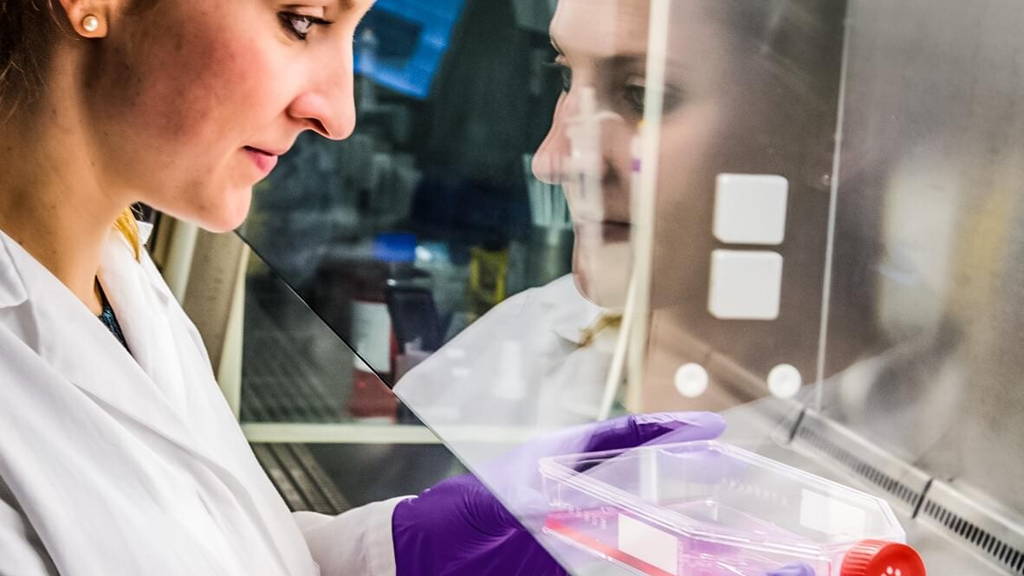Biologists, chemists and physicians need to know how biological reactions occur inside the human body for a range of treatments. For example: to insert new implants, develop new active substances or to replace diseased tissue. The extracellular matrix (ECM) has an important role here. In human tissue it is the natural environment of cells and is responsible for important functions. Tissue specific composition makes it the ideal material for use in medical technology.
“However, it is very complicated to modify the matrix in such a way that it can be adapted to different uses, but still behave naturally”, says Dr. Monika Bach from the Department of Interfacial Engineering and Materials Science, in the Fraunhofer Institute for Interfacial Engineering and Biotechnology IGB.
To tackle this problem, the chemists and biologists at the Stuttgart research institute have developed a functional ECM, which supports natural cell behaviour even outside the body and which can be flexibly adapted to problems related to biology or to materials science.
One such possibility would be to coat implants so the body accepts them more rappidly. According to Dr. Bach, in principle, this technology would also be interesting to develop new materials that can be used to support healing in bones or wounds.“ The material could also be used to coat cell culture dishes in the laboratory. It provides cells with an ideal environment, so that they exhibit their natural growth properties during culture. Complex living material reacts very sensitively to even small changes in the environment.”
The cells pick up this modified sugar and use it as a building block to assemble molecules within the cell and in the ECM. This chemical group can then undergo a selective chemical reaction – a click reaction – with a suitable binding partner. Bach: “Imagine a fastener button: one half, the other half and then click.”
The advantage of the clicking together is that the selective chemical reaction has a high yield, without side reactions and under physiological conditions, without interfering in natural cell processes.
They then characterized the cell matrix and examined the influence of the functionalized matrix on cells. This “functionalized” ECM was developed together with the colleagues of the Institute of Interfacial Process Engineering and Plasma Technology IGVP of Stuttgart University. clickECM was supported by the Baden-Württemberg Stiftung and the Fraunhofer Discover Program.
“However, it is very complicated to modify the matrix in such a way that it can be adapted to different uses, but still behave naturally”, says Dr. Monika Bach from the Department of Interfacial Engineering and Materials Science, in the Fraunhofer Institute for Interfacial Engineering and Biotechnology IGB.
To tackle this problem, the chemists and biologists at the Stuttgart research institute have developed a functional ECM, which supports natural cell behaviour even outside the body and which can be flexibly adapted to problems related to biology or to materials science.
Supporting natural behaviour
Laboratory tests showed that the biomaterial fulfills its functions in spite of the additional artificial chemical groups and supports the natural behaviour of cells that are in contact with it, according to Prof. Petra Kluger, Head of the Department of Cell and Tissue Engineering. The IGB scientists currently look for collaborators to help them to develop specific products with the patented technology.One such possibility would be to coat implants so the body accepts them more rappidly. According to Dr. Bach, in principle, this technology would also be interesting to develop new materials that can be used to support healing in bones or wounds.“ The material could also be used to coat cell culture dishes in the laboratory. It provides cells with an ideal environment, so that they exhibit their natural growth properties during culture. Complex living material reacts very sensitively to even small changes in the environment.”
Exploiting natural cell metabolism
In order to equip ECM with artificial chemical groups, the scientists exploit natural cell metabolism and let the chemical groups incorporate themselves. For this purpose, cells isolated from human tissue samples are incubated in cell culture dishes with sugar molecules which differ from normal sugars in that they have a reactive artificial chemical group at one position.The cells pick up this modified sugar and use it as a building block to assemble molecules within the cell and in the ECM. This chemical group can then undergo a selective chemical reaction – a click reaction – with a suitable binding partner. Bach: “Imagine a fastener button: one half, the other half and then click.”
The advantage of the clicking together is that the selective chemical reaction has a high yield, without side reactions and under physiological conditions, without interfering in natural cell processes.
clickECM project
Within the clickECM project, scientists of the Fraunhofer Institute for Interfacial Engineering and Biotechnology IGB in Stuttgart developed the conditions and parameters needed for the cells to incorporate relatively high levels of labelled sugar into their extracellular matrix during their metabolism.They then characterized the cell matrix and examined the influence of the functionalized matrix on cells. This “functionalized” ECM was developed together with the colleagues of the Institute of Interfacial Process Engineering and Plasma Technology IGVP of Stuttgart University. clickECM was supported by the Baden-Württemberg Stiftung and the Fraunhofer Discover Program.








